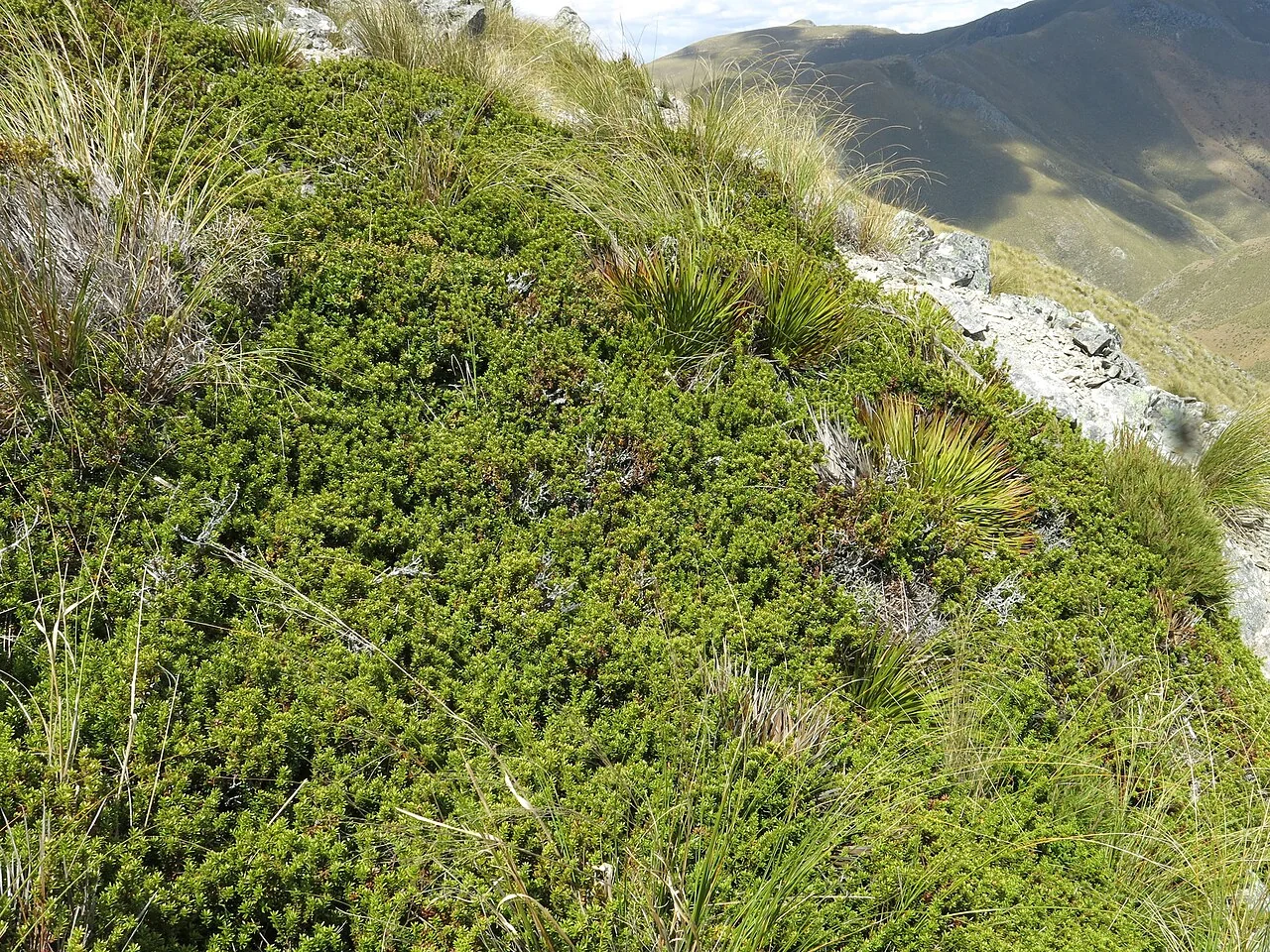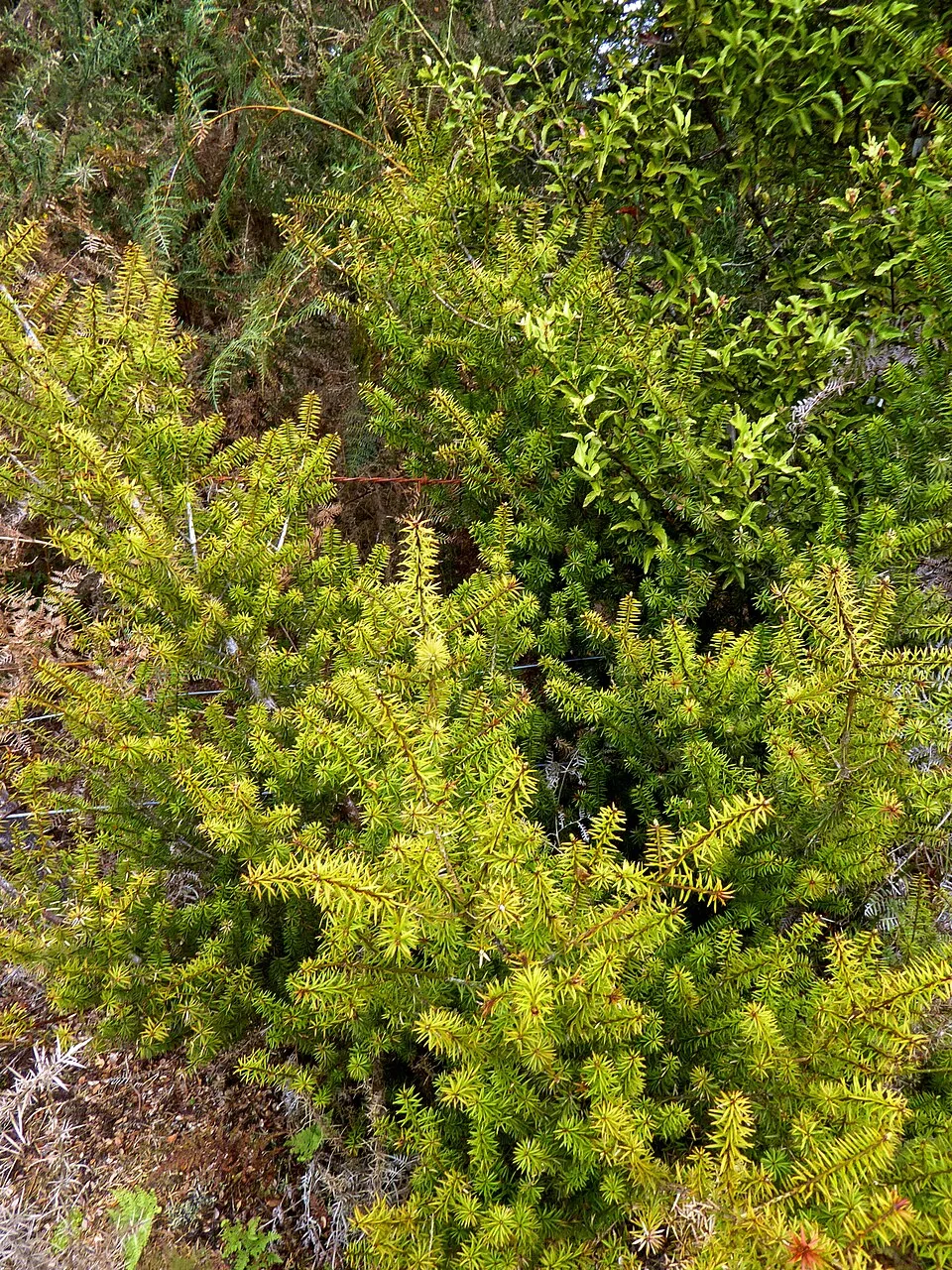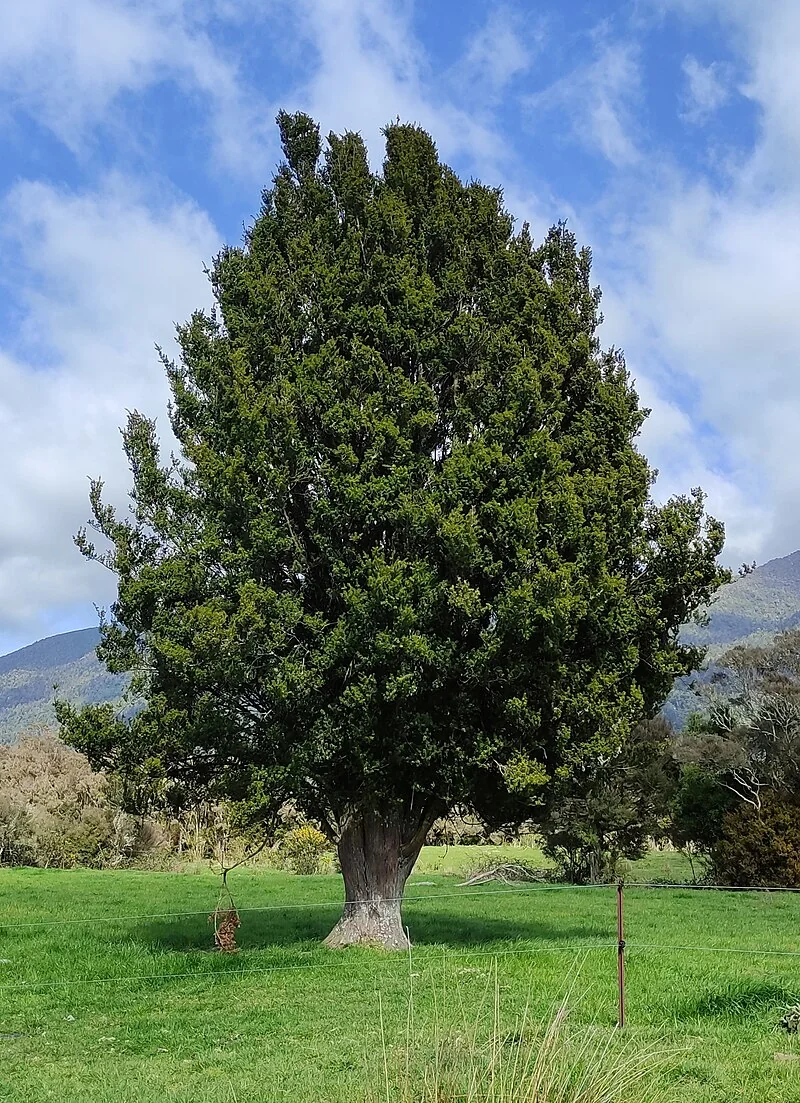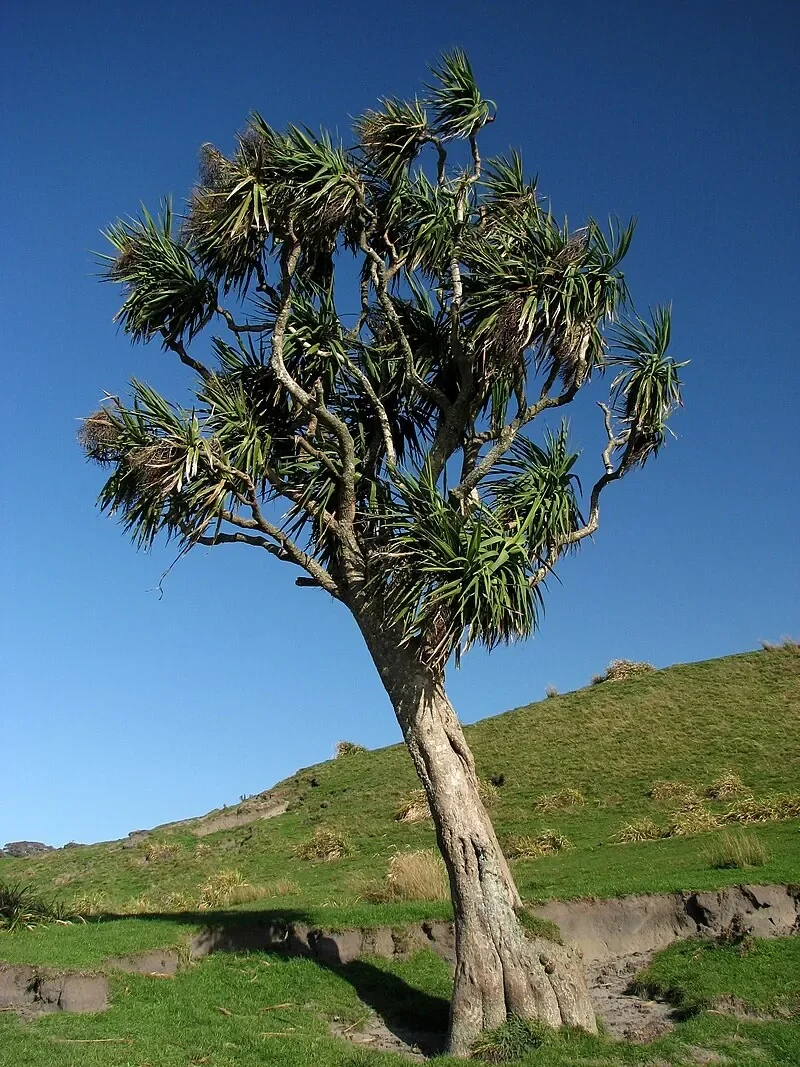
Mountain Tōtara
Podocarpus nivalis
A low, spreading alpine podocarp ideal for rock and alpine gardens; forms dense mats with small, tough leaves. Learn more in our native plants guide .

Plant Description
Botanical Features
Mountain Tōtara ( Podocarpus nivalis ), also known as snow tōtara, is a species of conifer endemic to New Zealand. It typically grows as a prostrate or sprawling shrub, usually 20-40 cm tall with spreading branches, but can also be semi-erect and reach up to 2 or 3 meters in height. Branches that touch the soil often root, allowing it to form mats several square meters wide. The leaves are thick, rigid, and closely spaced, arranged spirally around the branchlets. They are generally 3-10 mm long and 2-2.5 mm wide, boat-shaped to ovate-linear, and can be brownish-green, dark green, bronze-green, or sometimes dark wine-red or bronze-purple, especially as they age. The leaves have distinctly thickened margins and a prominent midvein. It is found in the North and South Islands of New Zealand, typically in subalpine to alpine scrubland and tussock grassland at elevations ranging from 800 m to 2,500 m above sea level. It is known for its hardiness, capable of withstanding temperatures as low as -25 °C and surviving long periods under snow. The plant produces succulent red arils, which are edible and have a sweet but resinous flavor.
Quick Facts
Overview
| Scientific Name | Podocarpus Nivalis |
|---|---|
| Height | 0.3-1.5 m |
| Spread | 1-3 m |
| Light | Full sun to light shade |
| Water Needs | Low-moderate; well-drained |
| Frost | Excellent |
| Frost Tolerance | Extremely hardy; alpine conditions |
| Salt Tolerance | Low; alpine species unsuited to coastal conditions |
| Growth Rate | Very slow |
| Lifespan | Long-lived alpine shrub |
Climate Best Suited to
Regional climate suitability across major New Zealand cities.
Regional Suitability
| Whangārei | Ideal |
| Auckland | Ideal |
| Hamilton | Suitable |
| Rotorua | Suitable |
| Tauranga | Ideal |
| Gisborne | Ideal |
| New Plymouth | Ideal |
| Whanganui | Ideal |
| Palmerston North | Suitable |
| Napier | Ideal |
| Wellington | Ideal |
| Nelson | Ideal |
| Christchurch | Suitable |
| Dunedin | Suitable |
| Invercargill | Suitable |
| City | Climate Suitability |
|---|
Natural Habitat
Mountain Tōtara ( Podocarpus nivalis ), also known as snow tōtara, is a conifer species endemic to New Zealand, found across both the North and South Islands, extending from Mount Hikurangi and Mount Pirongia southward.
Key Habitats Include:
- Montane to Alpine Environments: This species primarily thrives in montane to alpine environments, typically found at elevations ranging from 800 to 2,500 meters above sea level.
- Subalpine Scrubland and Tussock Grassland: It is commonly observed in subalpine scrubland, open tussock grassland, and at the upper margins of forests, showcasing its adaptation to high-altitude, exposed conditions.
- Rocky and Exposed Sites: Podocarpus nivalis is often found in open tussock grassland, herbfields, at the base of scree slopes, among boulder-falls, and on cliff faces and ridges, indicating its preference for well-drained, rocky, and exposed sites.
- Lowland Forests (less common): In some areas, particularly in Westland on the South Island, it can also be found in lowland forests, demonstrating some ecological flexibility.
Preferred Conditions:
- Cold Tolerance: It is known to tolerate cold conditions, often with abundant snow cover during winter, and is capable of withstanding temperatures as low as -25 °C.
- Drought Tolerance: Its hardiness extends to tolerating dry conditions, making it a resilient species in challenging alpine environments.
The presence of Podocarpus nivalis in these diverse and often harsh habitats underscores its ecological importance in contributing to the biodiversity and stability of New Zealand's unique alpine and subalpine ecosystems.
Plant Conservation
Conservation
Podocarpus nivalis , commonly known as mountain or snow tōtara, is a conifer species native to New Zealand. It is currently classified as "Least Concern" (LC) on the IUCN Red List of Threatened Species. This conservation status is attributed to its widespread distribution across the highland regions of New Zealand and the fact that it has not been significantly impacted by deforestation. The population of Podocarpus nivalis is considered stable. It thrives in montane to sub-alpine environments, frequently found in open grasslands and scrublands. Although localized erosion caused by overgrazing from livestock or introduced deer may lead to declines in certain areas, the species is protected within several national parks. Additionally, Podocarpus nivalis is cultivated as an ornamental shrub.
Growing Requirements
Soil
Well-drained, moderately fertile soils; avoid prolonged waterlogging.
Light
Performs in full sun to partial shade depending on species.
Water
Keep evenly moist while establishing; reduce irrigation as roots develop.
Temperature
Hardy in most regions of Aotearoa once established.
For Mountain Tōtara ( Podocarpus nivalis ), choose a site with full sun to light shade and soil that is well-drained, moisture-retentive. Incorporate composted organic matter to improve structure and drainage. Plant with the crown or root collar at soil level, then apply a 5-8 cm mulch to moderate temperature, conserve moisture, and suppress weeds. Protect young plants from extremes while establishing and consider the stated frost tolerance (seasonal) when siting near exposure or cold air drains.
Planting Guide
Best Planting Practices
Plant in full sun to light shade in cool regions, using a free-draining, gritty soil. Set plants slightly high and mulch with gravel to keep the crown dry. Water to establish.
- Soil: Lean, well-drained; avoid heavy, waterlogged ground.
- Spacing: 80-120 cm for groundcover mats.
- Aspect: Best colour and habit in open, cool exposures.
Ecosystem Notes
- Wind and frost: Prostrate form resists exposure and protects soil.
- Associates: Cushions, alpine grasses, and hebes in stony fellfields.
- Wildlife: Fruit supports birds; mats shelter invertebrates.
Uses and Significance
Garden and Restoration
A low, spreading alpine podocarp ideal for rock and alpine gardens; forms dense mats with small, tough leaves.
- Alpine and rock gardens
- Low evergreen groundcover
Propagate Mountain Tōtara from fresh, cleaned seed sown promptly, or by semi-hardwood cuttings taken from current season growth using a free-draining medium and gentle bottom heat. Germination can be slow; maintain even moisture and hygiene.
Cultural Significance
Cultural Importance
Alpine Podocarp Icon
Snow tōtara's naturally compact form makes it a favourite for rock gardens and alpine collections, showcasing the adaptability of New Zealand podocarps from lowland forests to high country.
While specific traditional uses for Podocarpus nivalis are not widely documented, other Podocarpus species, particularly the tōtara, have been historically utilized by the Māori people of New Zealand for medicinal applications and for wood in building and carving. Podocarpus nivalis , also known as snow totara or mountain totara, is a conifer endemic to New Zealand. Its berries are reportedly edible but are not particularly palatable and are considered more of a survival food. The plant is primarily valued today as an ornamental evergreen shrub or groundcover due to its slow growth, compact habit, and hardiness. It is also used for erosion control and is deer-resistant.
Landscaping Ideas
- Rock/alpine gardens: Excellent ground-hugging evergreen texture.
- Retaining walls: Spills over sunny, cool-facing walls with minimal care.
- Container troughs: Suits large alpine troughs with gritty mixes.
Seasonal Care Calendar
Spring
- Plant and mulch
- Protect new growth from weeds
Summer
- Deep watering in drought
- Monitor pests
Autumn
- Light formative pruning
- Top up mulch
Winter
- Plant eco-sourced stock
- Stake in windy sites
Pruning and Maintenance
Techniques and Timing
Generally minimal; formative work when young and removal of damaged wood.
Prune Mountain Tōtara lightly to maintain structure; remove damaged shoots and avoid hard cuts on older wood.
How to Grow Mountain Tōtara
Mountain Tōtara ( Podocarpus nivalis ) is a hardy, prostrate tōtara for alpine and subalpine sites. This unique New Zealand conifer is highly valued for its ability to thrive in harsh mountain environments, forming dense, spreading mats that provide excellent groundcover and erosion control. Its small, tough leaves and compact growth habit make it an ideal choice for rock gardens, alpine plantings, and exposed sites where other plants struggle. While it is a slow-growing species, its longevity and resilience make it a rewarding plant to cultivate. Understanding its propagation methods is key to successfully establishing this distinctive native.
From Seed
Propagating Mountain Tōtara from fresh seed is the most reliable method. Collect ripe arils (the fleshy, seed-bearing structures) when they are fully coloured and soft, typically in late summer to autumn. It is crucial to remove all fleshy tissue from the seeds, as this can inhibit germination. Wash the seeds thoroughly and sow them promptly, as fresh, clean seed gives the best results. Use a free-draining, sterile seed-raising mix, such as a blend of sand and fine pumice or perlite. Sow the seeds at a depth approximately equal to the seed's diameter and keep the medium evenly moist in bright, indirect light. Cool to mild temperatures (around 10-16°C) suit germination, which can be slow and irregular, often taking several weeks to months. Once seedlings have developed a few true leaves and their root systems are secure, carefully prick them out into individual small pots, minimizing disturbance. Grow them on in light shade with steady moisture before gradually hardening them off.
From Juvenile Cuttings
Vegetative propagation of Mountain Tōtara from cuttings can be challenging, with success rates often variable. Short juvenile cuttings (5-8 cm) taken from non-flowering shoots in late summer to early autumn offer the best chance of success. Remove the lower leaves, lightly wound the base of the cutting, and treat it with a suitable IBA (Indole-3-butyric acid) rooting hormone to stimulate root development. Insert the cuttings into a very free-draining medium, such as coarse perlite with fine bark, under high humidity and gentle bottom heat (around 18-20°C) in bright, filtered light. Rooting is slow and variable, often taking several months. Pot on only once a firm root system has formed, and then gradually acclimatize the new plants to outdoor conditions. This method is generally more successful for experienced propagators or in specialized nursery settings.
Pests and Diseases
Common Problems and Solutions
- Root rot: Avoid wet feet; use raised beds in heavy soils.
- Scale: Treat with horticultural oil; improve airflow.
- Heat stress: In hot climates, provide afternoon shade and mulch.
Bonus Tip
After planting, top-dress with a thin layer of coarse grit rather than organic mulch-this keeps stems dry and mimics its natural alpine scree habitat.







